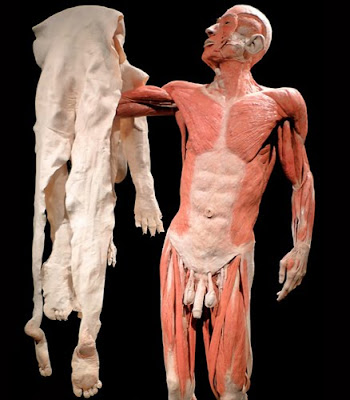
Correct! A body.
In this work, two women wrap a spectator from the audience in copper fabric. The idea is that the copper cuts the person off from all the electromagnetic signals that constantly surround us. The person is no longer 'plugged in' to mobile phone, TV, radio or wi-fi signals.
The 'Shroud/Chrysalis' title is symbolic of the ambiguity in the image. Viewers are to decide whether what they are looking at is a chrysalis or a body bag; birth or death. The idea behind this is that it makes us question the influence that all the new technology we are submerged in has. Will it be the death of us or our transition into a new age?
I love the fact that the spectator becomes part of the work. In the environment of an art gallery, where you wouldn't dream of even touching ANYTHING, someone from the audience is asked to exist inside the piece of art itself; the ultimate taboo. It's been said that sometimes later spectators aren't aware that there's a person inside the fabric, and come to the conclusion there's is a machine inside making it 'breathe'.
A body laying in a bag on a glass table makes for a striking image. Its binding conveys ritualistic undertones and its isolation mirrors the isolation of the spectator inside; cut off from both the outside and the virtual world. A holiday on Summerisle springs to mind.
I also love this piece because the questions raised are present only here and not in the corporate world. I'm fascinated by the idea of electrical hypersensitivity, where people report reactions to electromagnetic fields. The symptoms these people claim to experience in response to these fields are numerous, and include headaches, rashes and muscle aches. Although electrical hypersensitivity is not recognised as a medical condition, a very recent study concluded that 'electrical hypersensitivity can occur as a bona fide environmentally-inducible neurological syndrome'.
Shroud/Chrysalis is a fantastic illustration of the way scientists busy themselves looking for answers while artists are the ones who are asking all the important questions. In light of the study I mentioned, perhaps dropping the latter part of its title wouldn't be the end of the world.









